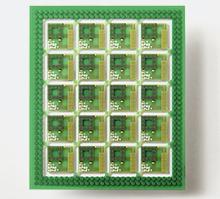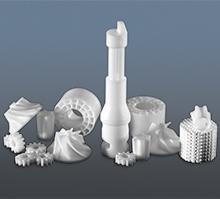Founded by a team of photonics researchers, the company has taken a patented technology with applications in biological and medical imaging and used it to create a new medical device for the real-time diagnosis of melanoma, including skin cancer. A strong IP portfolio helps the company to ensure technological exclusivity and secure a lasting advantage over competitors.
Études de cas sur les PMEVue d'ensemble
Études de cas sur les PME

Summary
L'OEB a produit une série d'études de cas sur les petites et moyennes entreprises (PME) européennes qui tirent profit des brevets et d'autres droits de propriété intellectuelle (PI) pour réussir.
Des PME de plusieurs pays, en activité dans différents secteurs industriels et domaines technologiques, ont été interrogées sur leur stratégie de PI et le modèle d'entreprise sous-jacent. Les études de cas ainsi obtenues montrent comment des PME nouvelles et des PME bien établies ont développé les capacités de gestion de la PI dont elles ont besoin et comment elles tirent profit de la PI.
Études de cas
Études de cas
A new dimension to skin cancer diagnosis
- Exercise caution in defining joint IP arrangements with supply partners, as this can dilute value for both parties and create unnecessary dependencies
- Align the geographical scope of patent protection with your long-term marketing strategy
- Secure appropriate funding that enables you to prioritise long-term strategies with high potential over limited short-term gains with lower risk
- Use patents and scientific publications to significantly enhance your company’s reputation, but pursue a strategy that avoids unintentional disclosures

Advanced medical imaging system
| Type of material | Download |
|---|---|
| Case study | |
| Review article | Creating IP for impact: Three EPO case studies (EN) |
Lutter contre la grippe à l'aide des algues rouges
- Les modèles de licence flexibles augmentent les chances de créer des situations gagnant-gagnant.
- Faire appel à un spécialiste de la PI à un stade précoce de la phase de R&D peut améliorer la protection par brevet pour des applications commerciales ultérieures.
- La négociation est le moyen privilégié pour résoudre d'éventuelles questions de contrefaçon ; le litige est considéré comme un dernier recours.
- Les marques peuvent ajouter de la valeur aux brevets et prolonger la protection au-delà de la durée de vie du brevet.

En tant qu'entreprise de découverte de médicaments, Marinomed s'appuie largement sur les brevets. Ses inventions sont validées dans une centaine de pays. L'entreprise gère et fait valoir activement son portefeuille de PI, qui contient également quelques marques. L'exploitation de ses droits de PI est fondée sur deux grands modèles de licence.
| Type de document | Téléchargement |
|---|---|
| Étude de case | Marinomed (EN) (PDF, 476 KB) |
| Marinomed (DE) (PDF, 476 KB) | |
| Chapitre de livre | IP for investors (EN) (PDF, 1MB) |
Recycling waste heat to cool down the planet
- University spin-offs need access to the relevant IP early on.
- Patent attorneys must understand the invention and the company's business case.
- Patents help to communicate a company's technical advantage and innovation skills.
- Access to joint inventions without joint patent ownership can be achieved using cross-licensing agreements.

This former university spin-off sells standard components for heat power generators that recycle waste heat by turning it into electricity. Early acquisition of university patents was vital in order to attract funding. Orcan co-operates with other companies, but simplifies its patent management by avoiding joint ownership.
| Type of material | Download |
|---|---|
| Case study | Orcan Energy (EN) (PDF, 733 kB) |
| Orcan Energy (DE) (PDF, 588 KB) | |
| Book chapter | From spin-out to international player (EN) (PDF, 1866 kB) |
Breathing new life into aerosol drug delivery
- Customers, investors and partners consider it very important for a young company to have strong IP.
- Company scale-up must go hand in hand with IP portfolio-building.
- To successfully commercialise innovative technologies, IP strategy must be clearly laid out and closely aligned with other key business functions.
- Competitor watches and patent searches are essential components of IP management.

When a company transforms from a small start-up to a global leader in aerosol technology for drug delivery in acute care, its strategic partners must be able to rely on the quality and protection of the products on offer. Key to addressing this challenge is a strong patent portfolio protecting both the core technology as well as a diverse range of product applications.
| Type of material | Download |
|---|---|
| Case study | Aerogen (EN) (PDF, 408 kB) |
| Aerogen (DE) (PDF, 225 KB) | |
| Aerogen (FR) (PDF, 223 KB) |
At the cutting edge of cardiopulmonary diagnostics
- It is essential to take both internal and external influences on the patent portfolio into account.
- In-depth prior art searches must be conducted early in the creative process and then professionally verified during the patenting procedures.
- External expertise and support is important for obtaining feedback on IP strategy and implementing strategic choices.
- When creating and maintaining an IP portfolio, it is vital to keep costs down without sacrificing quality.

This medical device company is founded on sound IP. Sound IP increases visibility and recognition, facilitates co-operation with partners and justifies premium prices. Establishing IP early in the process safeguards investment in R&D and offers protection from imitation until compliance with regulatory standards is achieved.
| Type of material | Download |
|---|---|
| Case study | Cosmed (PDF, 574 kB) |
Smart infusion pumps for treating patients at home
- Continuous innovation supported by patents allows technology-based SMEs to compete with large companies.
- Patent protection can help safeguard investments and reduce risk when introducing new products to the market.
- Well-thought-out filing strategies enable companies not only to speed up the granting process but also to postpone decisions where needed.
- Regular searches in patent databases allow companies to monitor competitors and reveal opportunities for future innovations.

As a medical technology company, Micrel uses patents and patent information strategically to safeguard future product lines, ensure freedom to operate and find inspiration for new technical developments.
| Type of material | Download |
|---|---|
| Case study | Micrel (PDF, 286 kB) |
Integrating ICT creates solutions for the Internet of Things
- Patents can be used to secure freedom to operate, for example by means of cross-licensing agreements.
- They can contribute value when developing a marketing strategy.
- Options to postpone decisions in the patenting process can be used strategically in order to gain time or to optimise procedural and validation costs.
- Even pending patents can contribute a significant business value.

Working on the Internet of Things, the company profited from a pending patent application, using it as an asset when negotiating freedom to operate for some of its business.
| Type of material | Download |
|---|---|
| Case study | Webdyn (EN) (PDF, 248 KB) |
| Webdyn (FR) (PDF, 203 KB) |
Snowflake pattern precipitates a new application for antennae
- A proactive, long-term IP strategy which is consistent with the overall corporate vision is essential.
- A patent portfolio based on continuing R&D allows companies to focus on technology licensing and helps secure financing.
- Litigation is a last but important resort when it comes to fighting wilful infringement.
- The Unified Patent Court (UPC) has the potential to remove the disadvantages of the current fragmented European litigation system.

Fractus, a producer of antennae, has built its business success on licensing its patented technology. Its robust IP portfolio and its commitment to enforcing its rights strengthen its position in licensing negotiations and safeguard further R&D investments.
| Type of material | Download |
|---|---|
| Case study | Fractus (PDF, 4333 kB) |
Leveraging IP: from research tools to industry applications
- IP strategy and management skills can help overcome the challenges presented by business model changes.
- Patents can be used to shape a company´s technology competency profile.
- Combining trade secrets and patents can be a cost-efficient and effective way to protect IP.
- Joint ownership of a patent is an acceptable option if there is a clear agreement benefiting both parties.

IP protection helped Ekspla to enter the market for industrial laser applications and take part in publicly funded international projects. Ekspla engages in joint patenting with its partners and combines patents with trade secrets where appropriate.
| Type of material | Download |
|---|---|
| Case study | Ekspla (PDF, 793 kB) |
Capacitance creates a watershed in purification
- Strong patents aligned with a company's products help secure exclusivity in core markets.
- IP strategy should evolve with company development, with IPRs contributing in different ways at different stages.
- Patents can help establish commercial partnerships which provide additional funding, R&D support and new business networks.
- A holistic approach to IP management means constantly developing new and advanced skills and tools.

As a producer of advanced materials for energy storage, Skeleton knows that it needs a strong patent portfolio if it is to keep on improving its technology and expanding its market. Employees at Skeleton are cross-trained so that everyone can support the IP strategy and its alignment with the company's R&D efforts.
| Type of material | Download |
|---|---|
| Case study | Skeleton (PDF, 397 kB) |
Capacitance creates a watershed in purification
- Strong patents aligned with a company's products help secure exclusivity in core markets.
- IP strategy should evolve with company development, with IPRs contributing in different ways at different stages.
- Patents can help establish commercial partnerships which provide additional funding, R&D support and new business networks.
- A holistic approach to IP management means constantly developing new and advanced skills and tools.

Obtaining patents for its water-softening and deionisation technology enabled Voltea to spin out from a larger company. The patents helped it to attract investors, set up co-operation with partners, and ultimately establish itself as a leader in the field.
| Type of material | Download |
|---|---|
| Case study | Voltea (PDF, 372 kB) |
Additive manufacturing (3D printing) opens a new chapter for ceramics
- A university's IP strategy can have a big impact on the success of any spin-off.
- It is good practice to have dedicated IP managers who take IP issues into account in the course of the company's day-to-day business.
- An open climate can foster employees' creative ideas and channel them into successful projects.
- Even minor technical improvements can meet a market need and be worth patenting.

University-owned patents created the springboard for this spin-off to enter the market for Additive manufacturing (3D-printed) ceramics in industrial applications. Measures stimulating the creativity of staff and research partners yield new and patentable ideas, supporting the build-up of the company’s patent portfolio and strengthening its market position.
| Type of material | Download |
|---|---|
| Case study | Lithoz (EN) (PDF, 321 kB) |
| Lithoz (DE) (PDF, 280 KB) | |
| Video | Working with inspiring technology – Lithoz |
| Study | Patents and Additive Manufacturing - full report (EN) |
| Further information | The future of manufacturing |
Pipe repairs that break the rules but not the walls
- Patents can help expand a service company's business model to include high-value products.
- Customers and resellers can provide important information about infringement which can be used to enforce patent rights.
- Integrating IP experts into the core team can help to streamline IP management processes and make them more efficient.
- Customers inputs and IP landscaping can provide vital stimulus for future innovation.

This traditional construction and renovation contractor expanded its activities to include the development of mechanical solutions. The decision to patent these solutions meant that sales of the resulting products, which are in part easy to copy, now play a major role in the company’s success.
| Type of material | Download |
|---|---|
| Case study | Picote (PDF, 441 kB) |
- Terms of use
-
The EPO SME case studies have been produced by the EPO in co-operation with external experts.
The content of the information provided in the case studies is for general information and training purposes only. It is subject to change at any time and without prior notice.
The information contained in the case studies does not constitute either advice of any kind or the rendering of consulting services or other professional services of any kind.
The information and materials contained in the case studies may contain inaccuracies or errors. Neither the EPO nor its agents nor the external experts make any representations or warranties about the accuracy, comprehensiveness, completeness or suitability of any of the information provided in the studies.
The EPO, its agents and the external experts will not accept any responsibility for any loss or damage that may arise from reliance on the studies, and exclude any and all liability for any loss, claim or damage, cost or expense suffered in connection with their use.
The case studies and/or any of their parts, as well as any modification or translation thereof, may be used for non-commercial teaching and training purposes only.
For inquiries please contact smecasestudies@epo.org.
En savoir plus sur les études de cas de PME:
Voir aussi
L’OEB vous recommande également d’explorer le contenu suivant: